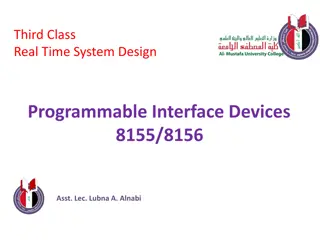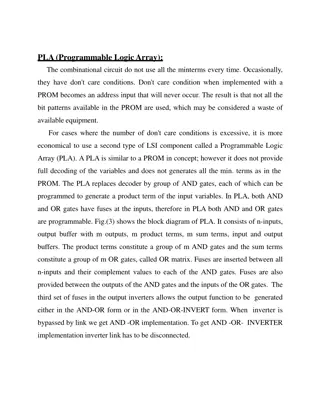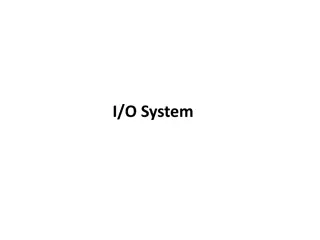Understanding Programmable Logic Devices (PLD) in Digital Electronics
Programmable Logic Devices (PLDs) are versatile electronic components used to create reconfigurable digital circuits, distinct from fixed-function integrated circuits. PLDs require programming before use, enabling customization for specific functions. This article explores PLDs, digital electronic systems, memory devices, microprocessors, and logic devices in detail.
Download Presentation

Please find below an Image/Link to download the presentation.
The content on the website is provided AS IS for your information and personal use only. It may not be sold, licensed, or shared on other websites without obtaining consent from the author. Download presentation by click this link. If you encounter any issues during the download, it is possible that the publisher has removed the file from their server.
E N D
Presentation Transcript
A programmable logic device (PLD) is an electronic component used to build reconfigurable digital circuits. Unlike integrated circuits (IC) which consist of logic gates and have a fixed function, a PLD has an undefined function at the time of manufacture.[1] Before the PLD can be used in a circuit it must be programmed (reconfigured) by using a specialized program.
Digital Electronic Systems Memory 1 Microprocessors 2 Logic 3
Memory Computer memory is any physical device capable of storing information temporarily, like RAM (random access memory), or permanently, like ROM (read-only memory). Memory devices utilize integrated circuits and are used by operating systems, software, and hardware.
Microprocessors A microprocessor is an electronic component that is used by a computer to do its work. It is a central processing unit on a single integrated circuit chip containing millions of very small components including transistors, resistors, and diodes that work together.
Logic Devices Logic devices provide specific functions, including device-to-device interfacing, data communication, signal processing, data display, timing and control operations, and almost every other function a system must perform
Logic Devices Fixed Function Logic Devices 1 Programmable Logic Devices 2
Fixed-Function Logic Devices Fixed function logic refers to digital logic devices, such as a 7408 quad 2-input AND gate, whose operation cannot change. Circuits that require digital logic other than that in a particular device must use other logic devices.
Programmable Logic Devices A programmable logic device (PLD) is an electronic component used to build reconfigurable digital circuits. Unlike integrated circuits (IC) which consist of logic gates and have a fixed function, a PLD has an undefined function at the time of manufacture.
Advantages of Programmable Logic Devices Advantages of using PLDs are 1- less board space, 2- faster, 3-lower power requirements (i.e., smaller power supplies), 4- less costly assembly processes, 5- higher reliability (fewer ICs and circuit connections means easier troubleshooting), 6-availability of design software.























